Challenge 3: How might we leverage digital technologies to engage citizens in water loss management and change their behaviours to improve water security?
WaterWatchers: Empowering South African Communities to Safeguard Water through Collective Reporting and Action
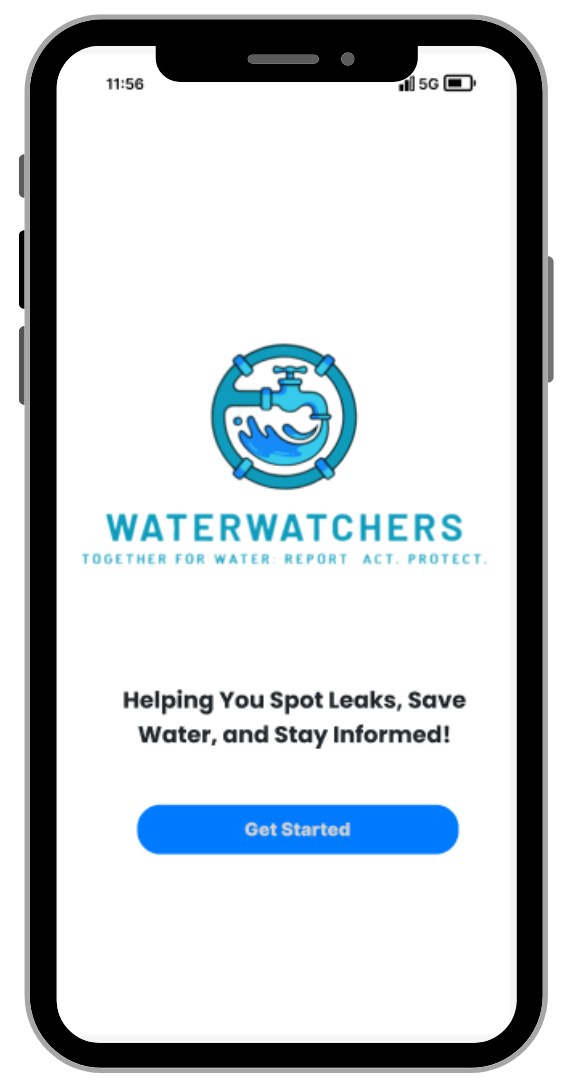
Introduction
South Africa is going through a water crisis that threatens public health, economic development, and overall quality of life. Across the country, water supply systems are under strain, leading to significant wter loss caused by aging infrastructure, poor maintenance, underinvestment, and vandalism. These issues result in the loss of nearly 50% of treated water, primarily due to leaks and burst pipes. This not only wastes a critical, limited, and life-sustaining resource, but also leads to substantial financial losses.
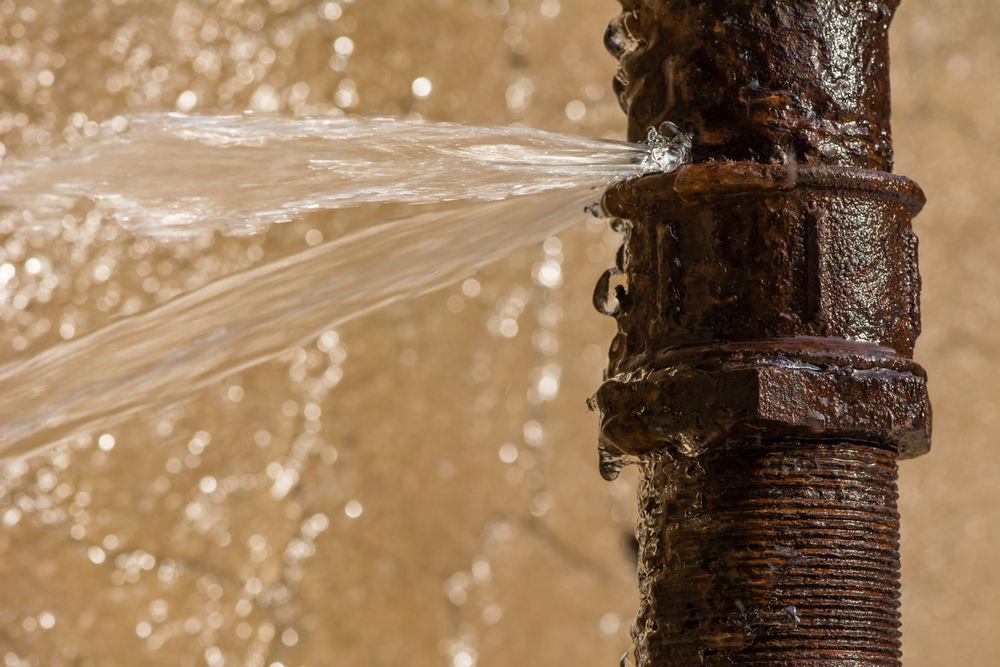
The combination of high water losses and increasing demand for the resource makes it urgent to find effective solutions and take action to address the problem. Community involvement is essential for an effective solution, but currently, most people are not very engaged with the issue, as it often feels intangible or distant. Many citizens don’t know the difference between a leak and a burst, or how these problems affect water availability and the country’s economy. Additionally, most people don’t know how to report a leak, and are often unwilling—or unable—to spend time figuring it out, calling, and waiting for a response. That is why, involving citizens to actively report issues, engaging them through fun and interactive learning about water, and helping them feel part of both the problem and the solution, can play a key role in safeguarding water.
The Solution
WaterWatchers is a mobile application that makes it easy to report water leaks or pipe bursts across the city. All reports are uploaded to a centralized interface, where AI is used to continuously sort them by urgency, ensuring the system is always up to date. This allows municipalities to quickly identify and prioritize the most critical issues. Once a problem is fixed, the municipality updates the status on the platform, moving the report to “resolved.” The citizen who submitted the report receive a notification, thanking them for their contribution and informing them that the issue has been addressed.
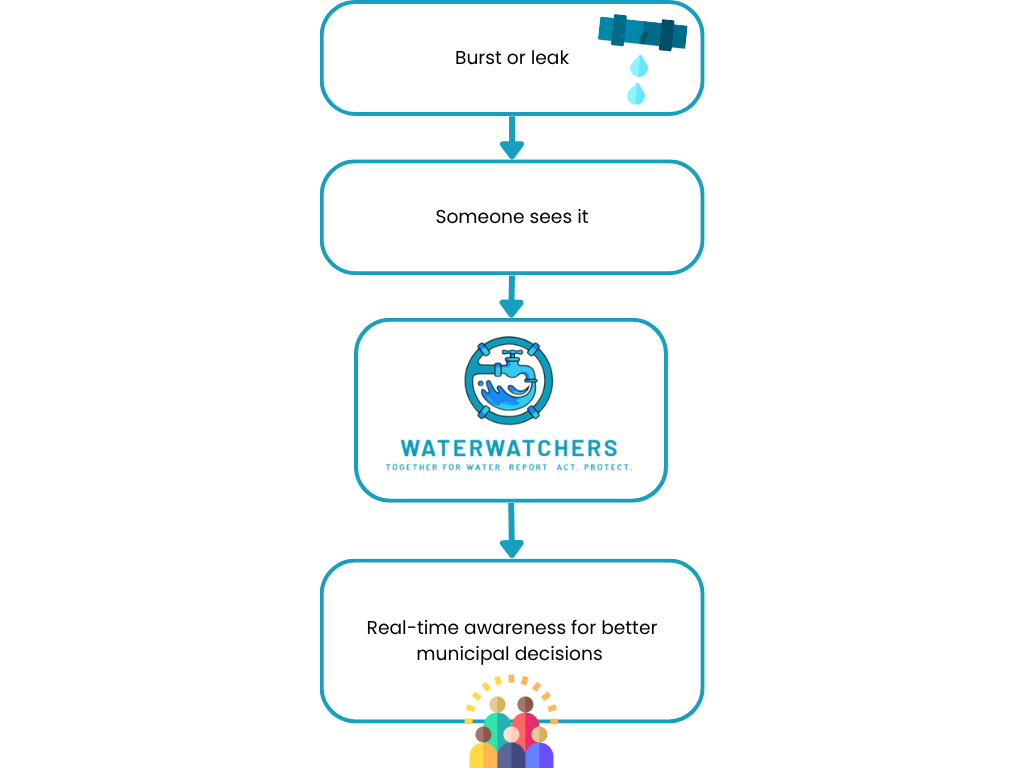
How the system works?
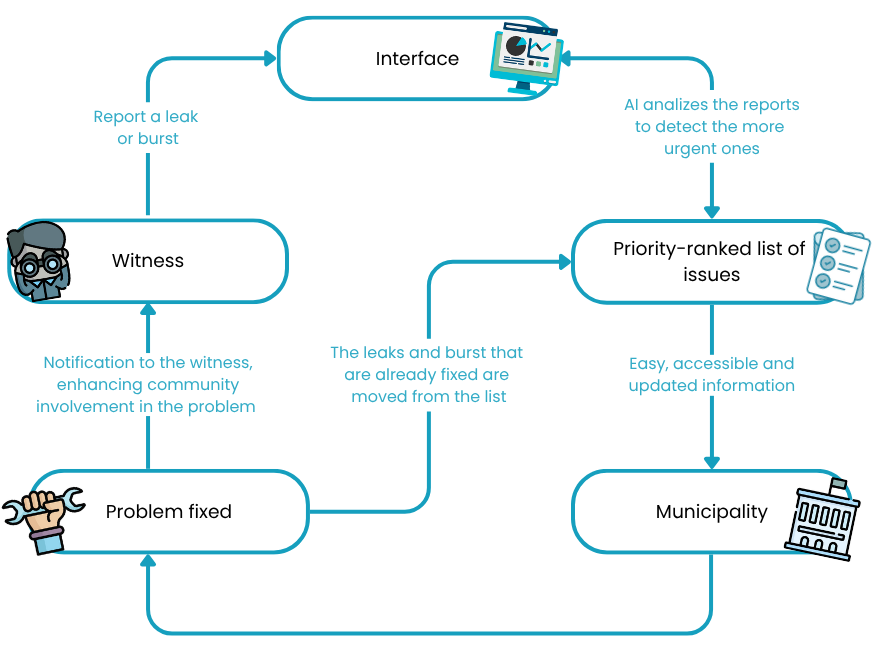
The system works by including citizen participation who have access to a smartphone with a camera and an internet connection. Upon observing a leak or a burst, which will now be referred to as events, they can easily help report the issue with the help of their smartphone, they can take a photo or video and submit a report, including the location of the event
An Artificial intelligence model, trained on geolocation verification, analyzes all the submissions, group the ones referring to the same event, discards false ones, and sorts the events by priority. The leak type and urgency level is determined by the AI model. Using visual AI analysis to categorize leak severity the leak is prioritized. The municipality has live access to this prioritized list, allowing them to know exactly where to go to address the water losses. This provides clear, up-to-date information, making the municipality’s work more efficient and faster.
Once the issue has been resolved, the municipality updates the system to indicate that the event has been fixed. This information is sent to the interface, which removes the event from the active list and adds it to a list of resolved cases. The interface then sends a notification to the individuals who reported the issue, thanking them and providing an estimate of how much water was saved thanks to their report, easily expressed in terms of glasses of water. While not a standardized measurement, this helps users visualize the magnitude of their contribution.
The application will be a pathfinder which will help users to know about the water incidents at real time. It will include a map that allows users to view different events in their area, submit new reports, and track how many “glasses of water” they have helped save over the time they have been using the application.
The application prototype
Since the product is a mobile application, the first step is to create an interactive prototype. This prototype demonstrates how the app would function in its various uses and was created using Figma.
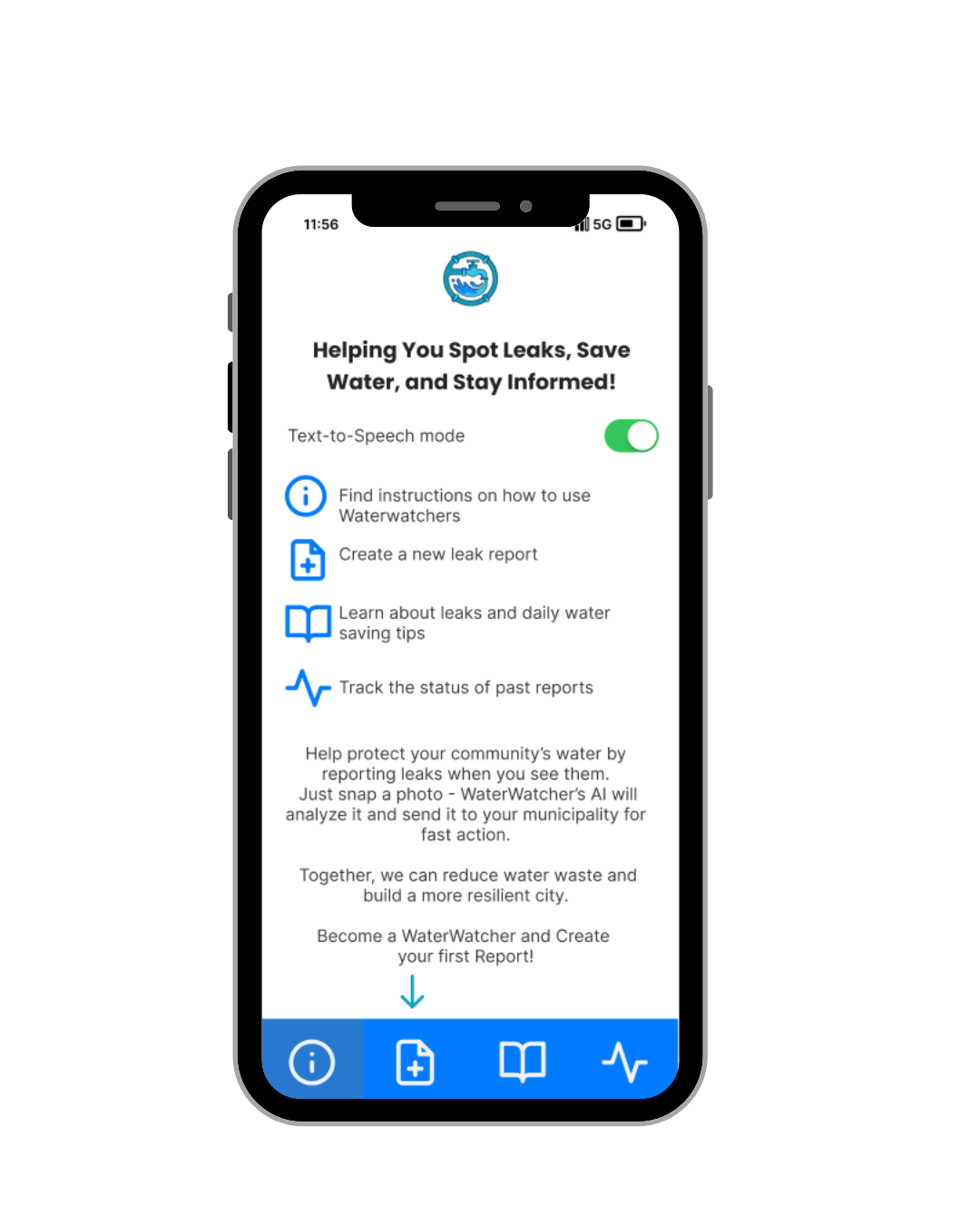
Once you launch the application and grant the necessary permissions (camera and location access), the prototype demonstrates how to create a report. It also provides educational content about water and allows users to view their past reports and see how much water they have helped to save. For a better understanding of the app’s functionality, you can explore the interactive prototype.
The interface prototype

Business model
WaterWatchers has a sustainable B2G business model where the primary paying client and beneficiary is a government entity, although citizen engagement is critical to its operational effectiveness. The business model can be laid out using the Sustainable Business Canvas.
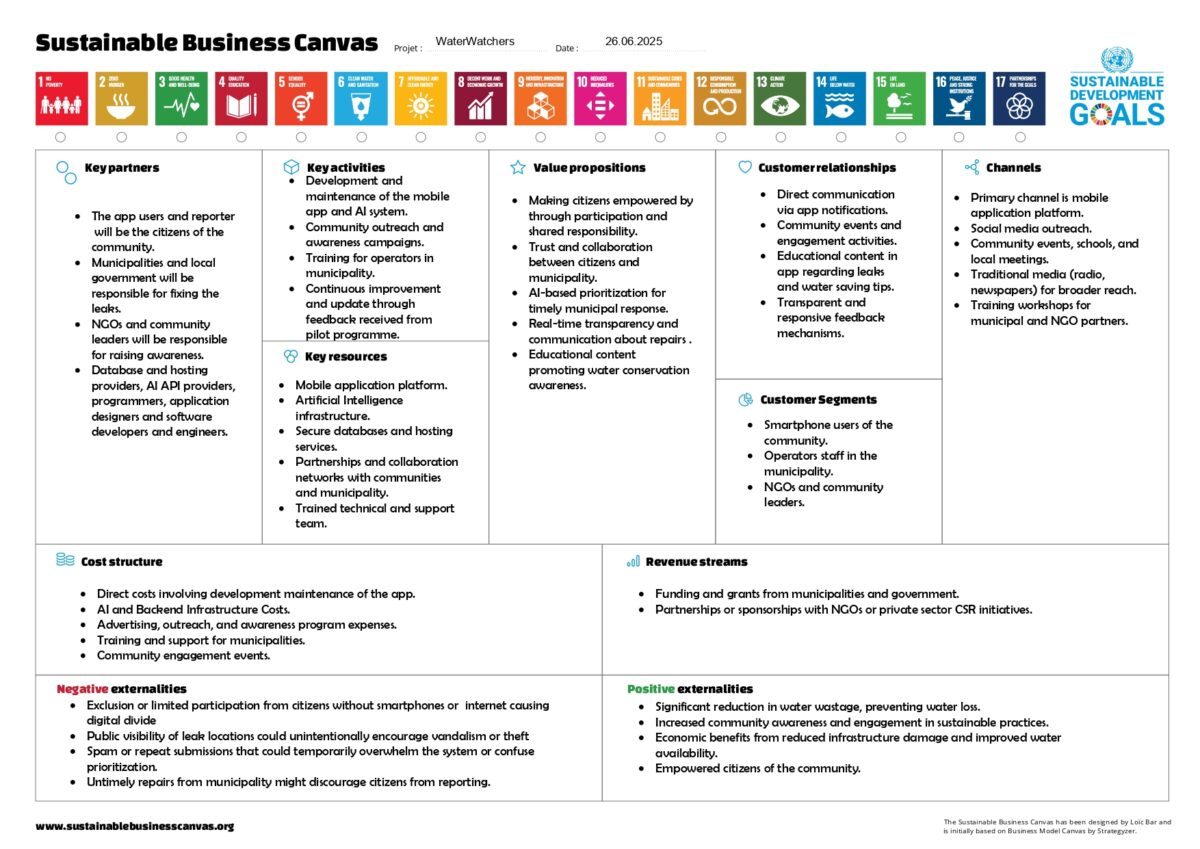
Implementation Plan
Once the application and interface are ready, the next critical step is extensive community outreach. As mentioned, the success of WaterWatchers depends entirely on community participation. This means launching a multi-channel campaign that includes social media, schools, radio, community centers and local events. Educational workshops and partnerships with NGOs and schools can further promote awareness and encourage adoption of the app.
Pilot programs will be rolled out in selected municipalities to gather feedback, test system performance, and ensure a smooth integration into existing municipal workflows. These early programs will allow iterative improvements in the user experience before a wider launch.
Training sessions will be provided for municipal staff to ensure effective use of the backend dashboard, and technical support teams will be available to troubleshoot issues during the early implementation phases.
Limitations & Externalities
While WaterWatchers is a promising and scalable solution, the following limitations must be acknowledged:
- Smartphone Access: Not all citizens have access to smartphones or reliable internet. Alternative offline, in person, or SMS-based reporting methods may need to be explored to ensure inclusivity.
- Infrastructure: Reports are only effective and encouraging to complete if municipalities have the capacity and resources to act on them. In under-resourced areas, even well-reported incidents may not translate into timely repairs.
- Duplicate Reports: Despite filtering, there is potential for spam or repeat submissions that could temporarily overwhelm the system or confuse prioritization.
- Vandalism: Publicly visible leak maps might accidentally draw unwanted attention to infrastructure, making them susceptible to vandalism if not properly protected.
Usability Considerations
Designing for all users means considering varying levels of digital literacy. While icon-based navigation is used, and processes are simple, early prototype is a Minimal Viable Product, not built for all digital literacy levels. Future usability considerations for the app include:
- More visual instructions and infographics
- Voice prompts and text-to-speech features for low-literacy users
- Multilingual support for local languages
- Low data mode to reduce barriers for users with limited internet access
- Download prompt of the tracking report for reported, active and resolved cases of the users
AI Concerns
Using artificial intelligence introduces powerful capabilities for leak reporting, but also critical responsibilities:
- Model Accuracy: AI must be trained with local data to recognize relevant leak scenarios. Misclassifications could delay responses or overlook urgent issues.
- Bias & Blind Spots: The system may initially underperform in certain areas or environments if not adequately trained on diverse conditions. Ongoing updates and community feedback will be essential.
- Over-reliance Risk: AI is a tool, not a replacement for human judgment. All final decisions on response prioritization remain with municipal staff and repair team.
Data Privacy & Trust
Trust is the foundation of citizen participation, and the key to WaterWatcher’s success. It is important to be transparent about the data use, and ensure the following:
- No personal data is stored or shared without consent
- Reports are anonymized before being processed or mapped
- Data is stored securely on encrypted servers, with strict access controls
- Location permissions are optional, and used only when the user submits a report
Users should have full control over their data, with the ability to view, manage, or delete their submissions anytime. We aim to comply with South Africa’s POPIA (Protection of Personal Information Act) and global best practices for privacy and security.
Conclusion
WaterWatchers is more than an app, it’s a citizen-first movement rooted in digital innovation and community empowerment. By making it easy, intuitive, and meaningful to report water losses, we turn everyday citizens into active guardians of our most critical resource, water. Combined with real-time AI analytics and municipal collaboration, this system can reduce water loss, speed up repairs, and create a deep sense of shared responsibility and trust. In the context of South Africa’s growing water crisis, very drop saved matters, and every person counts. WaterWatchers turns action into impact, and awareness into resilience.
The Team behind WaterWatchers

Masters student in Environmental Engineering at DTU. Experienced in water treatment, environmental analysis, and use of tools like AutoCAD, WAVE, and QGIS.

Masters student in Design & Innovation. Experienced in Design thinking, Innovation & Entrepreneurship and product and system design

Masters student in Human-Centered Artificial Intelligence at DTU. Experienced in programming back-end (ML/AI ), UX design and in computational data analysis.

Masters student in Economics at KU. Experienced in data management with data analysis and visualization skills.
